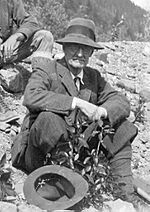Harry Fielding Reid facts for kids
Quick facts for kids
Harry Fielding Reid
|
|
|---|---|

Dr. H.F. Reid in Southeastern Alaska. (USGS photo by Charles Will Wright, 1933)
|
|
| Born | May 18, 1859 |
| Died | June 18, 1944 (aged 85) |
| Nationality | American |
| Scientific career | |
| Fields | Geophysics |
| Doctoral advisor | Henry Augustus Rowland |
| Other academic advisors | James Joseph Sylvester |
Harry Fielding Reid (born May 18, 1859 – died June 18, 1944) was an American geophysicist. He is famous for his important ideas about seismology, especially his theory called elastic rebound. This theory explains how faults (cracks in the Earth's crust) are connected to earthquakes.
Contents
Who Was Harry Fielding Reid?
Harry Fielding Reid was born in Baltimore, Maryland, in 1859. He was one of seven children. His father was a successful sugar merchant. His mother's family was related to Betty Washington Lewis, who was the sister of the first U.S. President, George Washington.
As a young person, Harry studied in Switzerland for a while. He also graduated from the Pennsylvania Military Academy. In 1877, he went to the new Johns Hopkins University. He earned his first degree in 1880 and then started his Ph.D. program. He studied physics with Henry Augustus Rowland and math with J. J. Sylvester. In 1885, he earned his Ph.D. for his work on the light patterns of platinum.
While in graduate school, Harry married Edith Gittings. They had two children: Francis Fielding Reid, born in 1892, and Doris Fielding Reid, born in 1895.
His Early Adventures and Studies
After finishing his studies, Reid spent about two years (1884-1886) traveling and studying in Europe. He may have worked in a lab in Berlin, Germany. His wife and mother-in-law joined him on these travels.
In 1885, Reid and his family lived in Cambridge, UK. There, he became friends with J. J. Thomson, a young physicist who later won a Nobel Prize. Thomson is famous for discovering the electron. Their friendship lasted for many years.
When Reid returned to the U.S. in 1886, he taught physics and math at the Case School of Applied Science in Cleveland, Ohio. After eight years, he moved back to Baltimore and joined Johns Hopkins University.
Exploring Glaciers
While in Cleveland, Reid became very interested in glaciers. He decided to study how glaciers move and change. In 1890, he organized a trip to Glacier Bay in Southeast Alaska. He went with several students.
This trip led to his first important scientific paper, which was published in the National Geographic Magazine. In 1892, he went on a second trip to Alaska. Back then, Alaska was mostly wilderness. Reid took careful measurements of how the glaciers were moving. He also suggested a theory about how the front of a glacier keeps its shape. Later, the United States Geological Survey (USGS) named one of these glaciers after him.
Understanding Earthquakes
After his glacier studies, Reid spent the next 35 years teaching and researching at Johns Hopkins University. He became a Professor of Dynamic Geology and Geography.
In 1902, Reid started collecting data about earthquakes for the USGS. At that time, the study of earthquakes, called seismology, was very new. There were only a few machines called seismographs in the world that could measure earthquakes. One was set up at Johns Hopkins. In 1911, Reid wrote the first full book on seismology in English.
The Great San Francisco Earthquake
The 1906 San Francisco earthquake gave Reid a huge chance to advance his work in seismology. He was chosen to be the only non-Californian scientist to study this massive earthquake.
Reid carefully looked at how different parts of the land along the California coast had moved over the past 50 years. Using data from the USGS, he figured out that the earthquake happened because of forces he called "elastic strain." This strain slowly built up along the San Andreas Fault. When the strain became too much, it was released in a huge earthquake.
Scientists in Europe had wondered if faults were connected to earthquakes. But it was Harry Fielding Reid who clearly showed that there was a strong connection. He called his new idea the "Elastic Rebound" theory. This theory is still a key part of how we understand earthquakes today.
Recognition and Legacy
Harry Fielding Reid became known as a leading scientist in geophysics in the Western Hemisphere. He was elected to the National Academy of Sciences in 1912. He also served as president of the American Geophysical Union from 1924 to 1926. In 1926, he and his wife traveled to Japan for an international conference on earthquake studies.
Reid died on June 18, 1944. He is remembered as one of the "founding fathers" of geology. Every year, the Seismological Society of America gives an award for the best work in seismology. This award is called the Harry Fielding Reid Medal, honoring his important contributions.

